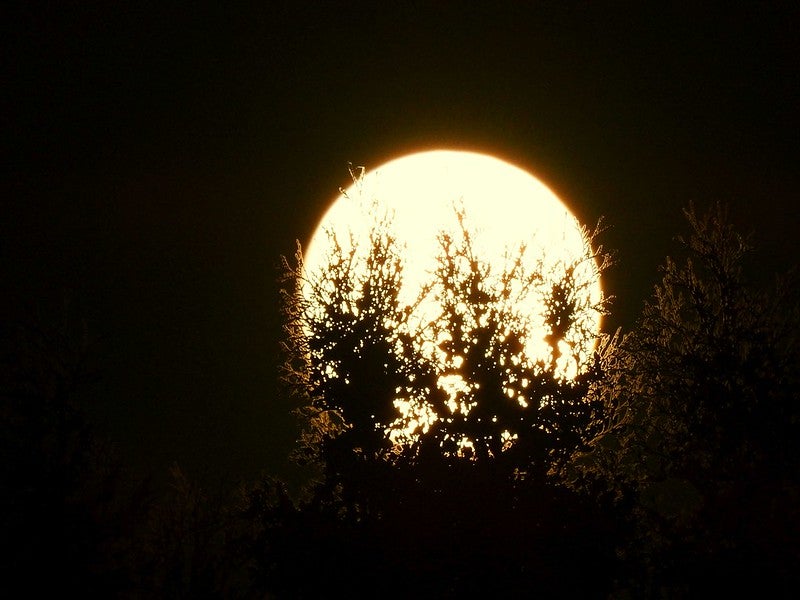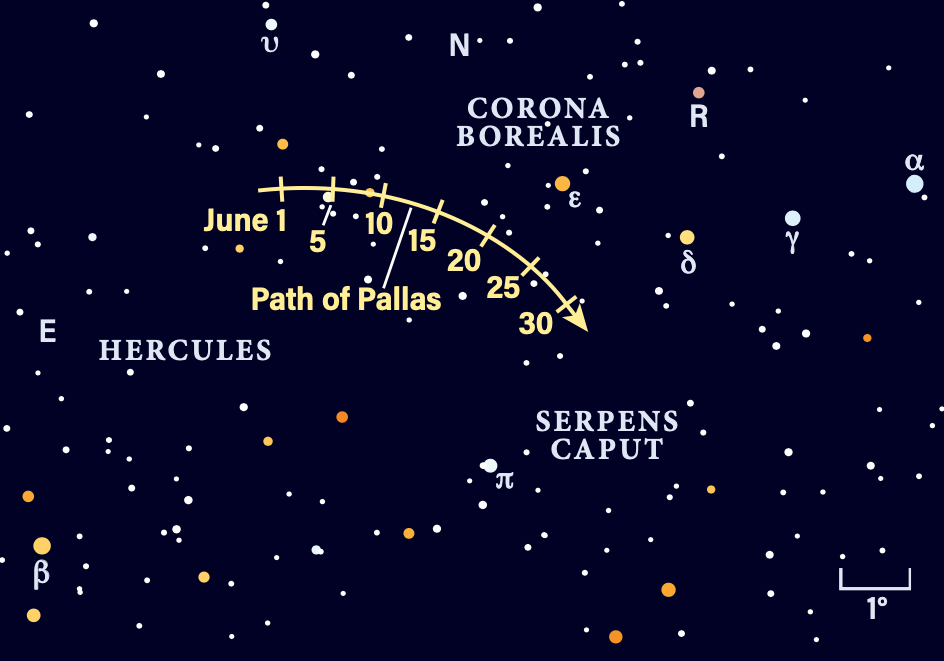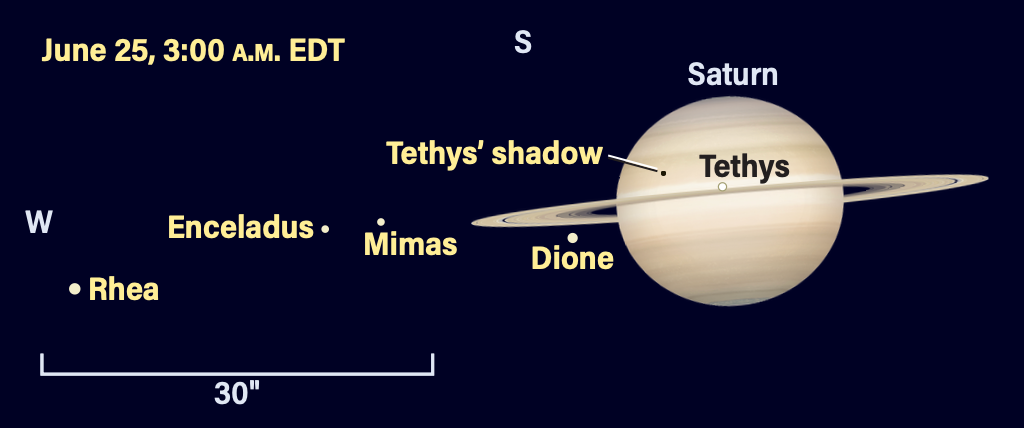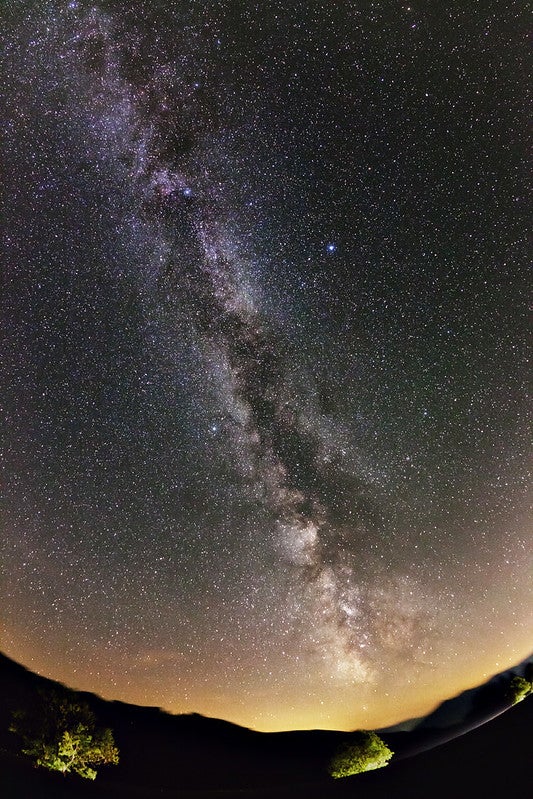
Friday, June 21
June’s Full Moon occurs at 9:08 P.M. EDT, just over a day after the summer solstice marked the beginning of that season in the Northern Hemisphere. June’s Full Moon is also called the Strawberry Moon, and you can catch it rising opposite the Sun, peeking over the eastern horizon less than half an hour after the Sun sets in the west. The Full Moon always rises around sunset, in fact, simply because of the geometry that allows us to view the fully illuminated face of our satellite. This means that the earlier or later your sunset, the earlier or later your moonrise as well. Far northern latitudes might not see sunset and moonrise until near or after midnight.
Although the name “Strawberry Moon” conjures up images of a pink-hued Moon, Luna will look as ivory as ever as she sails through the sky. If you notice the face of the Moon looks yellow or golden as it rises, this is essentially a trick of the light that occurs for the same reason sunrise and sunset are tinged yellow, orange, or red — the Moon’s reflected light must travel through more of Earth’s atmosphere near the horizon to reach us, which preferentially scatters away shorter (bluer) wavelengths of light. The effect will lessen as the Moon rises higher in the sky, returning it to white.
Sunrise: 5:32 A.M.
Sunset: 8:32 P.M.
Moonrise: 8:52 P.M.
Moonset: 4:39 A.M.
Moon Phase: Full
*Times for sunrise, sunset, moonrise, and moonset are given in local time from 40° N 90° W. The Moon’s illumination is given at 12 P.M. local time from the same location.

Saturday, June 22
Within two hours of sunset, asteroid 2 Pallas is high in the east, passing some 20′ due east of the recurring nova T Coronae Borealis tonight. Everyone’s eyes are on this fascinating star this summer; normally glowing around magnitude 10, it’s expected to briefly flare up into naked-eye range and reach magnitude 2, roughly the same brightness as Polaris, the North Star.
But let’s start with Pallas, which itself currently glows at 9th magnitude, just a bit brighter than T CrB. It’s been traveling in a southwestern arc through Corona Borealis and is now approaching the border of neighboring Serpens Caput, crossing into that constellation in just a few days. For a brighter signpost to find it, you can first locate Epsilon (ϵ) CrB, at magnitude 4.1, and center your scope there. Then, turn off your tracking. Less than 10 minutes later, Pallas should sit centered in your eyepiece.
Less than half a degree to Pallas’ west tonight is T CrB. This star last flared in brightness in 1946 and, although astronomers aren’t sure exactly when it will go off again, current estimates say it should experience another flare-up between now and September. It is one of fewer than a dozen known such recurring novae in our Milky Way, and because of its 80-year cycle, is only visible to the naked eye once every generation or so. So, make sure to keep tabs on this stunning star in the next few months to ensure you get to witness the event of a lifetime!
Sunrise: 5:32 A.M.
Sunset: 8:32 P.M.
Moonrise: 9:48 P.M.
Moonset: 5:37 A.M.
Moon Phase: Waning gibbous (99%)
Sunday, June 23
The Moon passes 1° north of dwarf planet 1 Ceres at 1 A.M. EDT this morning; for some, Luna also occults, or passes in front of, the rocky ruler of the main belt. Observers in the central and eastern U.S., as well as eastern Canada and northeastern Mexico, will see Ceres completely disappear behind the Moon for a brief period
In the U.S., the pair will rise close to each other in the constellation Sagittarius late on the 22nd, just east of the base of the Teapot asterism’s handle. The Moon will be hiding Ceres from view during the midnight hour.
Both the visibility and timing of the event are heavily location dependent. The dwarf planet will reappear in the skies above Chicago at 12:19 A.M. EDT and above New York City at 1:44 A.M. EDT. Note that Ceres currently shines at 8th magnitude, so it is invisible to the naked eye but can be easily captured in binoculars or any small scope.
If you want to know whether the occultation is visible from your location, you can check out the International Occultation Timing Association’s website.
Discovered in 1801, Ceres is the largest body in the main belt, spanning nearly 600 miles (965 kilometers) and containing roughly a quarter of the entire mass in the main belt. It is now classified as a dwarf planet.
Sunrise: 5:32 A.M.
Sunset: 8:33 P.M.
Moonrise: 10:34 P.M.
Moonset: 6:44 A.M.
Moon Phase: Waning gibbous (96%)
Monday, June 24
Look west after sunset to locate the form of Leo the Lion, striding headfirst toward the horizon. Just beneath his back leg is Comet C/2023 A3 (Tsuchinshan-ATLAS), soon to become what amateurs hope is the best comet of the year!
For now, Tsuchinshan-ATLAS is hovering around 10th magnitude, best seen with larger binoculars or any small- to medium-sized scope. It’s visible for a few hours after sunset as Leo sets, though the earlier you can catch it the better, before it sinks too low and becomes embroiled in the thicker, more turbulent air near the horizon. You can find the comet tonight just over 3° south of magnitude 4.1 Sigma (σ) Leonis. Tsuchinshan-ATLAS is also just 0.5° southeast of the elliptical galaxy NGC 3640, which should glow at the same magnitude as the comet. Given their similar brightnesses, it should be interesting to compare and contrast the pair’s shapes, sizes, and structures.
And, if you want a glimpse of the famous Leo Trio of galaxies, this popular grouping is an easy jump 10° due north of where Tsuchinshan-ATLAS and NGC 3640 sit tonight. The triplet lies close to 3rd-magnitude Theta (θ) Leo, just 2.5° southeast of this star.
Sunrise: 5:33 A.M.
Sunset: 8:33 P.M.
Moonrise: 11:12 P.M.
Moonset: 7:59 A.M.
Moon Phase: Waning gibbous (91%)

Tuesday, June 25
The space around Saturn is quite busy this morning as the small, 10th-magnitude moons Tethys and Dione put on a show. Note that this observation will be challenging because the moons are quite faint — larger scopes will improve the view, as will photographing or video recording the event.
Saturn rises around 12:30 A.M. local daylight time; depending on your location, certain events may already be underway. Prior to 3 A.M. EDT, magnitude 10.6 Dione is visible just north of the rings on Saturn’s western side, closing in on the planet. It disappears into the shadow of the ringed world around 3 A.M. EDT and crosses behind the disk itself some 43 minutes later.
At the same time, Tethys is transiting Saturn’s large, bright disk, moving from east to west and led by its tiny shadow. The moon is just skimming the southern edge of the rings, making it hard to spot — but an exceptionally rewarding sight if you do. Tethys’ shadow leaves the disk shortly before 3:40 A.M. EDT, while the moon continues its journey until roughly 4:20 A.M. EDT. After that, it will continue pulling away from the planet but remain just south of the rings — it might be easier to spot once it leaves the disk, as the contrast between the moon’s faint glow and the darker background will be greater.
Meanwhile, don’t forget to look for much brighter, 8th-magnitude Titan. Saturn’s largest moon sits far east of the planet this morning, some 2.7′ due east of the planet’s center.
Sunrise: 5:33 A.M.
Sunset: 8:33 P.M.
Moonrise: 11:44 P.M.
Moonset: 9:15 A.M.
Moon Phase: Waning gibbous (84%)
Wednesday, June 26
Jupiter is improving significantly in the morning sky. Now some 8° high an hour before sunrise, the solar system’s largest planet shines at magnitude –2. This morning the planet stands directly above fainter magnitude 0.9 Aldebaran, the bright red eye of Taurus the Bull, as the constellation rises in the east.
Jupiter’s four Galilean moons are on display this morning as well. Ganymede sits to the planet’s east and, in order of nearest to farthest, Io, Europa, and Callisto are to the west. Magnitude 1 Mars lies 24.5° to Jupiter’s west, higher in the sky in the constellation Aries. Roughly midway between them is Uranus, which requires binoculars to spot, as it glows a faint magnitude 5.8.
Continuing along the morning line of planets, magnitude 7.8 Neptune is 42.7° west of Mars, hanging below the Circlet of Pisces. This distant world also needs binoculars or a telescope to view. And finally, magnitude 1 Saturn stands at the end of the line, another 10.5° west of Neptune and dominating the faint stars of the constellation Aquarius.
In all, these planets span nearly 78° on the sky from Jupiter to Saturn. And as a bonus, the waning gibbous Moon lies an additional 17.7° west of Saturn, adding yet another world to the lineup this morning.
Sunrise: 5:33 A.M.
Sunset: 8:33 P.M.
Moonrise: —
Moonset: 10:30 A.M.
Moon Phase: Waning gibbous (74%)

Thursday, June 27
The Moon reaches perigee, the closest point to Earth in its orbit, at 7:30 A.M. EDT. At that time, our satellite will be 229,464 miles (369,287 km) away.
Skimming quickly through the sky, the Moon passes 0.08° north of Saturn at 11 A.M. EDT. It will sit to the right of the ringed planet in the morning sky for observers in the U.S., as this event takes place well after sunrise even on the West Coast. The Moon will keep moving rapidly along the morning lineup of planets, passing close to Neptune early tomorrow morning.
This evening, let’s check the progress of one of summertime’s most famous asterisms, the Summer Triangle, as it rises earlier each night. By two hours after sunset, the Triangle’s lowest star, Altair in Aquila, is already 30° high in the east, shining at magnitude 0.8. To its upper left is magnitude 1.3 Deneb in Cygnus. The Summer Triangle is capped off by its brightest star, magnitude 0 Vega, to Deneb’s upper right in Lyra.
At the height of summer, the Summer Triangle flies overhead around local midnight. With the plane of the Milky Way running through it, this region is rife with star clusters and nebulae, making it a popular locale for amateur astronomers to point their scopes. Even as summer is just getting started, this region is already high enough once it gets dark for you to begin your galactic explorations, so consider picking a few targets from the list linked above to start with. We’ll continue to highlight this region and its many treasures as the season progresses.
Sunrise: 5:34 A.M.
Sunset: 8:33 P.M.
Moonrise: 12:10 A.M.
Moonset: 11:44 A.M.
Moon Phase: Waning gibbous (64%)
Friday, June 28
The Moon now passes 0.3° north of Neptune at 5 A.M. EDT, just over 12 hours before our satellite reaches Last Quarter phase at 5:53 P.M. EDT.
If you want to find Neptune, this morning’s pairing will make it easier to locate the distant world, which requires optical aid to view. Located in Pisces, Neptune is 5.5° southeast of Lambda (λ) Piscium, the southeasternmost star in the Circlet asterism. But with the Moon much closer, you can simply use Luna as your jumping-off point this morning, though note that the faint planet’s light may be a bit harder to pick up with the bright Moon nearby. Through a telescope, Neptune spans just 2″ — see if you can pick out its “flat” disk among the nearby pinpoint-like stars.
Neptune is now some 2.765 billion miles (4.45 billion km) from Earth, which is why it looks so small. In reality, the ice giant is nearly 4 times as wide as Earth and more than 17 times as massive.
Sunrise: 5:34 A.M.
Sunset: 8:33 P.M.
Moonrise: 12:34 A.M.
Moonset: 12:56 P.M.
Moon Phase: Waning gibbous (52%)

Sky This Week is brought to you in part by Celestron.









